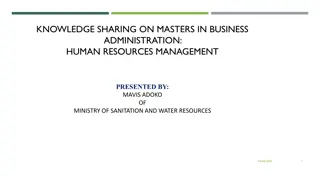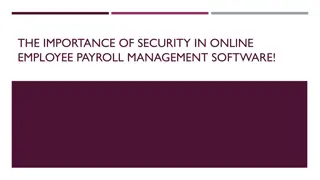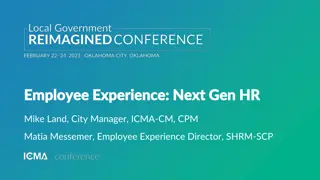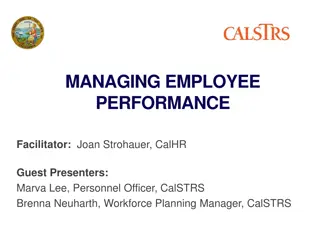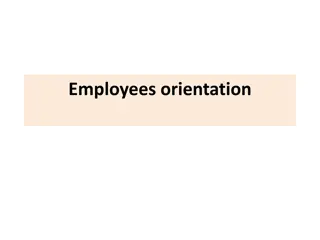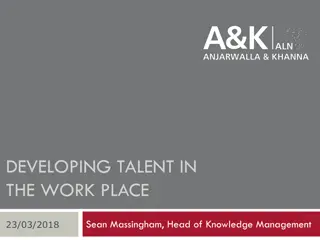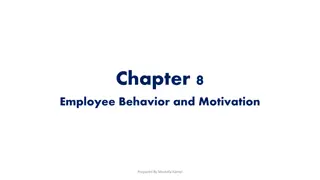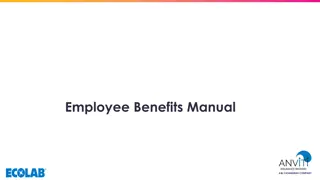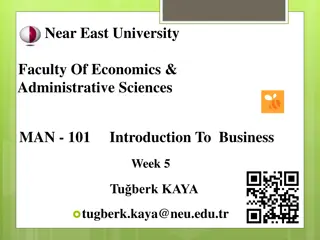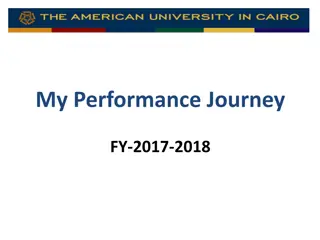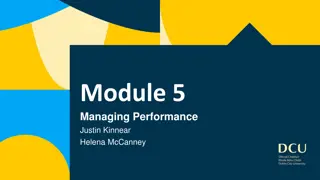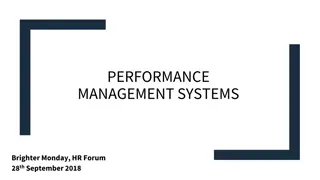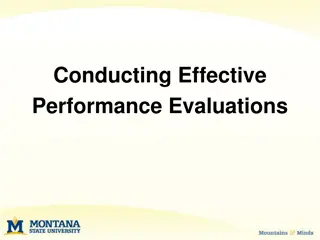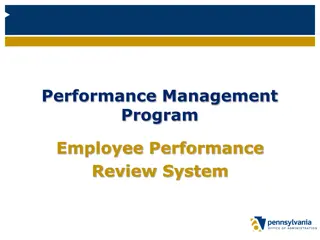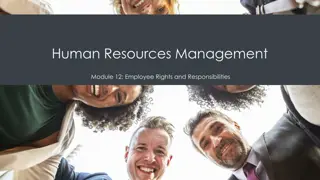Effective Performance Management Strategies and Employee Development
This content delves into the essential aspects of performance management, including setting SMART goals, conducting regular performance meetings, and providing constructive feedback to employees. It emphasizes the role of coaching managers in supporting employee development and success. Additionally, it highlights the importance of aligning employee objectives with job descriptions and fostering a collaborative work environment to achieve organizational goals effectively.
Download Presentation

Please find below an Image/Link to download the presentation.
The content on the website is provided AS IS for your information and personal use only. It may not be sold, licensed, or shared on other websites without obtaining consent from the author. Download presentation by click this link. If you encounter any issues during the download, it is possible that the publisher has removed the file from their server.
E N D
Presentation Transcript
NNEDV Performance Management Webinar Part 2 Presenter: Daria Kreher December 13, 2018
Performance Management II Objectives Review PM Part I Objectives process, manager involvement, setting strategy, job descriptions/competencies Elements of a SMART goal Creating a SMART goal Performance Development Plans
The Process Managers Coach Employees at Regular 1-1 Performance Meetings During the Year #1 Develop and Agree on Goals/Objectives and Personal Development Plan #5 End of Year Performance and Development Assessment #2 Meet Informally at Regular Intervals #3 Formal Mid-Year Assessment Conversation #4 Meet Informally at Regular Intervals
The Coaching Manager Actively listens Provides timely feedback Asks questions about employee s thoughts about performance Managers Coach Employees at Regular 1-1 Performance Meetings During the Year Removes roadblocks to development Encourages and makes suggestions Stays present in the meeting
Basic Elements of a Successful Employee Using the job description, the manager and employee agree on objectives based on job description. WHAT NEEDS TO BE DONE
Basic Elements of a Successful Employee Imbedded in the job description should be competencies behavioral skills that are usually learned through life experiences and are not technical skills. HOW THE WORK NEEDS TO BE DONE TO BE SUCCESSFUL
Developing a Strategy Statement The purpose of the Coalition is to eliminate domestic violence in our state. Our mission is to support and enhance the work of our member agencies and to provide leadership on the issue of domestic violence. TALENT MANAGEMENT RESOURCE ACCESS ADVOCACY EXTERNAL COMMUNICATION Create an environment of collaboration with partner agencies and access to information to our constituents. Create an environment that engages, develops, and retains high performing employee who deliver a superb experience to our students. Build and improve on former legislation and work with state legislators to pass new laws in our state to protect women and children affected by DV. Create, update and maintain timely training opportunities for everyone associated with DV in our state.
Why Set Goals/Objectives? Meet the organization s mission by way of a specific business strategy Provide a framework to achieve results Attain the vision by regularly reviewing performance Assess and identify success or opportunities for improvement Reset objectives when presented with business changes Provide support and resources needed for employee growth and development
Employee/Manager Collaboration Review what employee does in the day to day Ensure manager and employee agree Review department/divisional strategy (optional) Ask employee to write out her own goals Employee and manager meet to discuss and tweak goals Employee and manager agree on goals Employee keeps a copy of her goals for reference during the year Goals are recorded for the personnel file (or if available, in the HR system)
Setting Goals The SMART Way Specific What will you see/experience when the goal is accomplished? Measurable What progress will you see when the goal has been accomplished? Action How will the goal get done? What competencies will be used? Relevant Does the goal focus on making a real and sustainable difference? Will the accomplished goal add value to the business and personal performance? Time-bound Is there a deadline as to when the goal will be accomplished? 11
a goal Increase the number of donor solicitations
A SMART GOAL Specific Increase the number of solicitations from new donors Measurable by 20% (15 people/corporations) to achieve a revenue goal of $30,000. Action Create a strategy plan with potential donors; review with manager prior to taking action and discuss results with manager on a bi-weekly basis. Relevant PHILANTHROPY pillar of the agency s strategy and within scope of employee s job responsibilities. Time-bound April 15, 2019
CREATING A PERFORMANCE BASED CULTURE After goals are set, continue the process The PM process provides a platform for the employee and manager to continue the conversation The manager needs to make this a priority and the ED needs to hold managers responsible for accomplishing this responsibility This creates a culture that is focused on performance not once a year, but all year, every year. #1 Agree on Goals/Objectiv es #5 End of Year Performance #2 Meet Informally #3 Formal Mid-Year Assessment #4 Meet Informally
A Few Words on Performance Meetings Space Just the two of you in a space that allows for focused and open conversation. Time Allow sufficient time to get through your agenda and don t be late to the meeting. Agenda Helps keep you focused on what you want to accomplish in the meeting (engage the employee and have her create the agenda). Turn off the world No cell, laptop, phone, interruptions. Prepare Know what you want to discuss; have performance examples; know the organizational strategy; anticipate what the employee might say. Follow up If there are follow up items, ensure that either you or the employee capture them and are clear about expectations. 15
Summary TO High performance management culture driven by Managers not HR or the ED Continuous PM coaching conversations throughout the year SMART objectives defined and agreed upon by employee and manager Clearly defined manager expectations and accountabilities to manage performance Behaviors (HOW) are just as important as tasks (WHAT) employee is responsible to do Clear alignment of employee objectives to agency s goals. FROM Infrequent performance monitoring Event driven PM meetings (2 or fewer times per year) Objective setting not clearly defined Gaps in manager evaluation High tolerance for underperformers Achievements based only on ambiguous results (WHAT) Inconsistent integration to agency strategies
What Are Performance Development Plans (PDP)? Personal plan to create a defined goal to learn Based on manager observations about performance AND employee s desire to grow and learn Manager provides coaching and guidance to assist employee to understand strengths/opportunities for growth EMPLOYEE OWNS IT!
Why Are PDPs Important? To The Individual To The Business Develops a pipeline of employees for new and vacated roles Organizations with strong talent practices outperformed their peer group, earning 22% higher shareholder returns. McKinsey Organizations that revise or review goals quarterly are 45% more likely to have above-average financial performance and 65% more likely to be effective at holding costs at or below level of competitors. Bersin/Deloitte Drives employee engagement and performance Council Highlights opportunities for development in current and future roles Engenders a personal best sense of accomplishment Corporate Leadership
Id like to go to a conference 48% Challenging Assignments 18% Significant Other People 17% Other Events 17% Hardships
How We Learn -48% CHALLENGING ASSIGNMENTS Changes in scope function to multi-function country to region to global site to multi-site Special projects/task forces, especially with leader/people interaction Fix-its and turnarounds Start ups and green fields Line to staff moves Cross-organizational moves
How We Learn -18% OTHER PEOPLE Opportunity to interact with potential role models Opportunity to benchmark self against successful peers Coaching or mentoring by key internal leaders, executives or outside people with useful perspectives Situation in which other people challenge or test person s values
How We Learn -17% HARDSHIP (difficult to anticipate, but important to help people extract learning from the experience) Demotions, missed promotions, crappy jobs Business failures & mistakes Having to break out of a rut Dealing with subordinate performance problems Personal trauma
How We Learn -17% OTHER EVENTS Coursework (6.2%) First supervisory job and early work experiences (generally result in seminal learning) Purely personal experiences
Something To Consider When Developing a PDP How most people learn Most development plans 70% 10% ASSIGNMENTS 20% 20% PEOPLE <10% 70% COURSES
Development Opportunities Leading a project Working in a new functional area Increasing size of job in current area Researching needs for a new initiative Oversee a cost cutting initiative Volunteer on a community board or charitable organization
Essentials for a PDP SPECIFIC Do you want to fill a functional skill gap? Do you want to change or develop a behavioral capability? Make it clear and specific MEASURABLE What will success look like when you achieved this goal? What will you see, hear or feel that is different to behaviors observed today. Write down how you will know when success happens ACTION What actions will you take to achieve this goal? How will you be supported by your own actions and by your manager? Get creative and plan to do more than attend a class or continue to RELEVANT Will this goal support your career goal/path? Does it support an aspiration to improve performance or build on a strength? Think about what you want to do over the next year and plan for it here TIME BOUND When will you complete this task? Remember to update your plan with new timelines when necessary. Ensure that your learning is complete when you want/need it to be
Manager Guidelines for Assisting with PDP Creation DO DON T Agree on the plan with employee Create broad-based development recommendations based on assessment and 1-1 discussions Be prepared to provide time, resources and money for development Consider the agency s goals Help with follow through in 1-1 discussions Be creative in identifying development opportunities, removing obstacles and providing support. Write it for the employee Fail to actively participate in the development of your employee s plan Approve a plan which does not meet current or future business needs Agree on plans that will not be implemented until the following year Over-rely on coursework and conferences
Follow Up Review job descriptions and competencies Think about how you will assess your employees for the end of this performance cycle Determine how you can be a coach for your employee to ensure she: Is successfully performing her job responsibilities Understands her contribution expectations over the next year Has a plan to develop based on her specific goals Plan to carve out time to do this work managers manage people.
Performance Management Forms Assessment Parameters Number scores, words, expressions Address prior year Tasks and Behaviors performance Create new goals/objectives With employee/employer collaboration, document the personal development plan Ensure the form includes an area for manager overall comments and employee input Employee signature should be an acknowledgement not necessarily an agreement of what is in the document
Performance Forms Continued Search on Google for samples SHRM is a good source is you are a member of the organization Engage with a human resources professional to help create the form Having a form is essential to record the information, however, knowing why you are using the form and having a well thought out PM process will benefit your employees as well as your business
Thank you for joining the NNEDV Webinar! Daria Kreher daria.kreher@gmail.com








